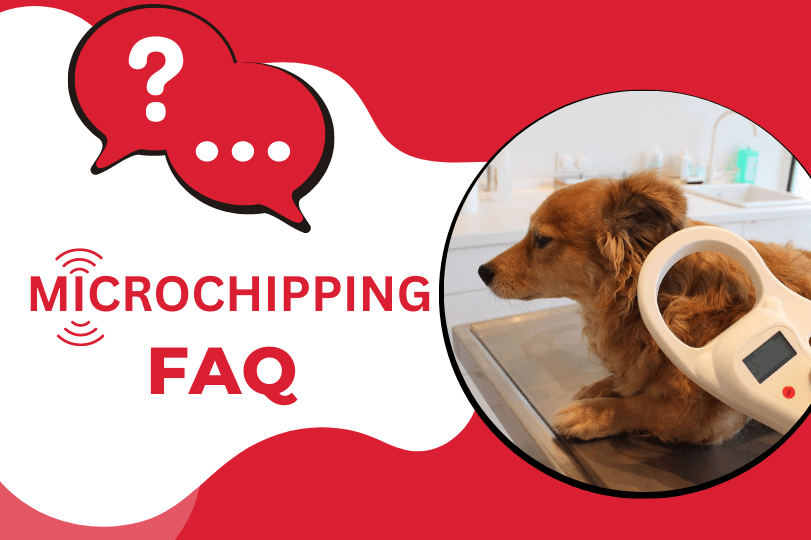Have you ever contemplated the possibility of our four-legged companions being separated from us? What if they stray a little too far, get lost, or are stolen? Oh god, what a nightmare it seems to be!
It’s much worse if we haven’t kept their ID tags updated or if their tags are misplaced along the way. In any such unthinkable circumstances, you would wish to reunite with them but then how would it be possible?
That is why you should – Microchip your pets.
The month of May is designated as ‘Chip Your Pet’ Month, and in recognition of that, we’d like to raise awareness about getting your pet microchipped. Continue reading to learn everything you need to know about microchipping your pets.
What is a Microchip?
With the advancement in technology, a microchip is a boon for pet owners. It would assure to reunite pets with their owners if they get separated sometime. A microchip is a small chip of a size of a grain. It is basically a radio-frequency transponder with a unique identity number. This identity number goes into a pet database in which all the details about the identity of the pet are registered.
What Exactly Is Done in Microchipping?
Microchipping your pet involves having a microchip inserted into their body by a practicing veterinarian. The procedure, however, doesn’t require a surgery or anesthesia. These potentially little life-saving and tamper-proof devices are very easy to administer and the procedure hardly takes a few minutes. It is more like a routine pet-vaccination in which the microchip is implanted using a hypodermic needle.
[Also Read] Valuable Tips for A Successful Virtual Vet Consultation
Is Microchipping Procedure Safe?
A dog microchip is generally inserted in the skin between its shoulder blades and the microchip will bond with the dog’s subcutaneous tissues in about a day. This bonding prevents the chip from moving around within the pet’s body. However, there’s a slight chance that it may move within the pet’s body before bonding but it cannot get lost within their body. Moreover, it is a safe procedure and most pet-owners have not reported any side effects of getting their pet microchipped.
Can You Track A Pet If It Is Microchipped?
No, you cannot. A microchip is often mistaken as a GPS system, but it cannot track your pet’s location or provide any information regarding your pet’s whereabouts. Moreover, it is not possible to install a GPS in your pet, as a GPS tracker would need a continuous energy source (something like a battery) and would need to plug in to charge, much like an electrical device. So impractical!
Nevertheless, a microchip can provide information regarding the unique identification number upon scanning. Most veterinary hospitals, police stations, and animal shelters have such scanners or microchip readers these days. They mostly offer such scanners for free or for a nominal fee. One can find out the identification number and the database with which it is registered with, by simply running such scanners over a pet’s body, and ultimately reunite them with their rightful owner.
What Is the Cost to Microchip A Pet?
The estimated cost of implanting a microchip is between $30 and $50. Many shelters, on the other hand, now provide already microchipped pets and include the expense of microchips in the adoption fees before they go to their forever homes. However, some vets may give you a discount if the microchipping is done at the same time as neutering, spaying, or placing the pet under anesthesia for something normal like dental treatment. Also, the charges of registration may or may not be included in this, so do check it with your veterinarian.
[Also Read] Tips To Save on Your Vet Bills
What You Should Do During This ‘Chip Your Pet’ Month?
We hope this blog has made you realize how essential microchipping is for both you and your pets. Thus, the first thing you can do during this ‘Chip your pet’ month is to have your pet microchipped if you haven’t done that yet.
If your pet has already been microchipped, make sure that the details registered on the database are accurate and up to date. If not, call the registry for the updates. Otherwise, it will be difficult for your missing pet to reunite with you.
Sometimes, it may happen that the individual who finds your lost-pet is unfamiliar with the microchips and thus doesn’t take it for scanning. In such a case, one won’t be able to identify the lost-pet with the microchip and the purpose of microchip will not be served. Therefore, do spread the word about microchips in your friend circle and on your social media during this Chip your Pet month.
This way, you can help us raise awareness about the microchip. Plus, it is such a simple process, there’s no maintenance beyond registering, its advantages outweigh any minor expenses, it will deter your pet from being sold, and will offer endless peace of mind if some unthinkable were to happen if you are separated from your pet.
FAQs About Pet Microchipping

Despite the fact that microchipping has shown to be effective in helping pet parents find their stolen or lost pets, many pet parents are either unaware of the procedure or forget to schedule it. Check out the responses to these frequently asked questions if you want to discover more about the significant advantages of pet microchipping.
What Does Microchipping Entail?
Animals are microchipped by injecting a unique RFID (radio frequency identification) microchip into them. The microchip is housed in a tiny, lengthy capsule that is roughly the size of a grain of rice. The microchip is typically implanted by the vet just beneath the skin, typically near the shoulders, where it stays for life.
One crucial piece of information is stored on the microchip: an exclusive identifying number linked to a national pet registry database. The energy from the RFID scanner causes the microchip to transfer this information to the scanner when an animal shelter employee points it at a microchipped pet, allowing the worker to get in touch with the pet parents.
Why Do Tag-Worn Pets Need Microchips Too?
If pets have identification collar tags, you could presume they don’t need to be microchipped. For the majority of people who locate a pet, collar tags do provide the quickest and most straightforward method of locating the pet’s owner. These tags, however, have the potential to come off the collar and make it difficult to identify your pet.
In addition to getting your pet microchipped as a secondary form of identification, you should always make sure that it wears collar tags with contact and immunization information. Even if your pet loses its collar, tags, or both, a microchip can still be read to get your contact information.
How Effective is Microchipping?
The likelihood that pet parents will find their missing best buddy increases significantly with microchipping. According to research, compared to just 22% of dogs without microchips, 52 percent of microchipped canines sent to shelters are reunited with their owners. To put it another way, using this straightforward method increases your chances of finding your lost pet by 238%.
When You Should Microchip Your Pet?
You might feel more confident about your chances of finding your pet if you microchip them as soon as possible. Technically, microchipping pets of any age is safe. However, after they are seven to eight weeks old, puppies typically handle the treatment better.





